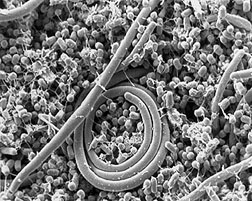This page has been archived and is being provided for reference purposes only. The page is no longer being updated, and therefore, links on the page may be invalid.
|
|
Salmonella Uses Chemical to CommunicateBy Sharon DurhamJanuary 27, 2000 Chemical communication between animals, particularly insects, has been well documented through scientific study. Now, add microorganisms to the list of creatures that communicate this way. An Agricultural Research Service scientist has found that Salmonella bacteria release a chemical that directly affects the growth of these organisms. Veterinarian Jean Guard-Petter, who is in ARS’ Southeast Poultry Research Unit at Athens, Ga., found that the food pathogen Salmonella enteritidis uses the chemical acyl-homoserine lactone, or AHL, as a communication tool. Each Salmonella bacteria puts out a low level of AHL, but when the population grows, so does the amount of AHL. At high levels, AHL prompts Salmonella to grow beyond its original genetic programming and signals cells to produce molecules that increase virulence. The abundance of these organisms in a confined space, such as the spleen of the chicken, forces them to move to another area, sometimes a hen’s eggs. Even though Salmonella contaminates a small fraction of the 45 billion eggs produced each year in the United States, this still translates into a significant amount of illness. Occurrences of S. enteritidis food poisoning have increased fourfold in the U.S. and 40-fold in Europe in the past 15 years. Petter was the first to see that AHL is a factor in S. enteritidis’ rapid growth and spread. She made her discovery by using a special plasmid reporter system that inserts genes in S. enteritidis bacteria. These genes cause the bacteria to emit light if they are producing AHL. As the light grows brighter, it indicates growth to a high cell density. Dr. Petter’s discovery may provide another tool for improving food safety. Read more about inter-bacterial communication research in the January issue of Agricultural Research magazine. ARS is the chief scientific agency in the U.S. Department of Agriculture. Scientific contact: Jean Guard-Petter, ARS Southeast Poultry Research Laboratory, 934 College Station Road, Athens, GA 30605; phone (706) 546-3446, fax (706) 546-3161, jgpetter@uga.cc.uga.edu. |

